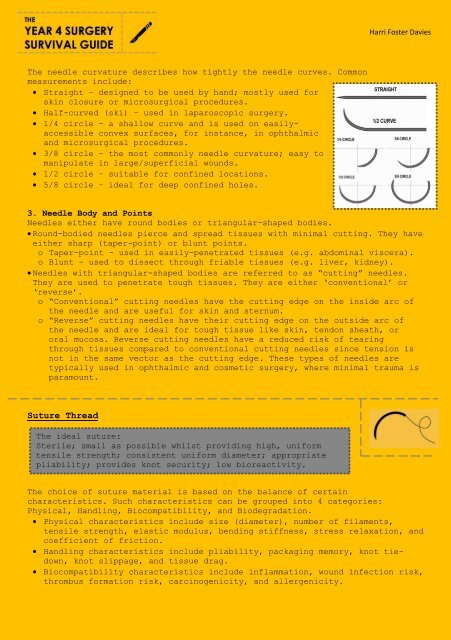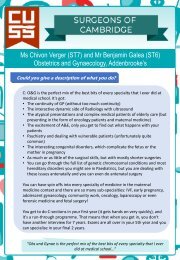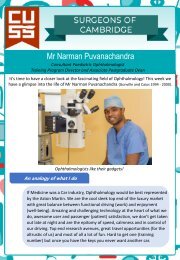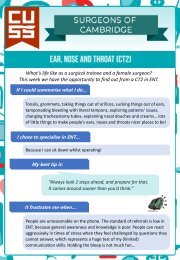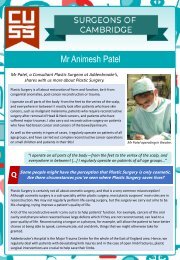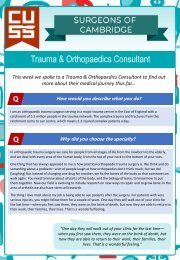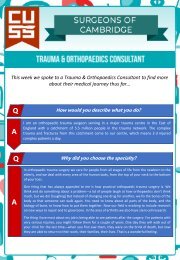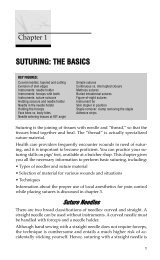An Introductory Guide to Suture Types
Knowing what's what with sutures doesn't have to be complicated. This bitesized guide by Harri Foster-Davies provides the information you need to know.
Knowing what's what with sutures doesn't have to be complicated. This bitesized guide by Harri Foster-Davies provides the information you need to know.
Create successful ePaper yourself
Turn your PDF publications into a flip-book with our unique Google optimized e-Paper software.
Harri Foster Davies<br />
The needle curvature describes how tightly the needle curves. Common<br />
measurements include:<br />
• Straight – designed <strong>to</strong> be used by hand; mostly used for<br />
skin closure or microsurgical procedures.<br />
• Half-curved (ski) – used in laparoscopic surgery.<br />
• 1/4 circle - a shallow curve and is used on easilyaccessible<br />
convex surfaces, for instance, in ophthalmic<br />
and microsurgical procedures.<br />
• 3/8 circle – the most commonly needle curvature; easy <strong>to</strong><br />
manipulate in large/superficial wounds.<br />
• 1/2 circle – suitable for confined locations.<br />
• 5/8 circle – ideal for deep confined holes.<br />
3. Needle Body and Points<br />
Needles either have round bodies or triangular-shaped bodies.<br />
• Round-bodied needles pierce and spread tissues with minimal cutting. They have<br />
either sharp (taper-point) or blunt points.<br />
o Taper-point - used in easily-penetrated tissues (e.g. abdominal viscera).<br />
o Blunt - used <strong>to</strong> dissect through friable tissues (e.g. liver, kidney).<br />
• Needles with triangular-shaped bodies are referred <strong>to</strong> as “cutting” needles.<br />
They are used <strong>to</strong> penetrate <strong>to</strong>ugh tissues. They are either ‘conventional’ or<br />
‘reverse’.<br />
o “Conventional” cutting needles have the cutting edge on the inside arc of<br />
the needle and are useful for skin and sternum.<br />
o “Reverse” cutting needles have their cutting edge on the outside arc of<br />
the needle and are ideal for <strong>to</strong>ugh tissue like skin, tendon sheath, or<br />
oral mucosa. Reverse cutting needles have a reduced risk of tearing<br />
through tissues compared <strong>to</strong> conventional cutting needles since tension is<br />
not in the same vec<strong>to</strong>r as the cutting edge. These types of needles are<br />
typically used in ophthalmic and cosmetic surgery, where minimal trauma is<br />
paramount.<br />
<strong>Suture</strong> Thread<br />
The ideal suture:<br />
Sterile; small as possible whilst providing high, uniform<br />
tensile strength; consistent uniform diameter; appropriate<br />
pliability; provides knot security; low bioreactivity.<br />
The choice of suture material is based on the balance of certain<br />
characteristics. Such characteristics can be grouped in<strong>to</strong> 4 categories:<br />
Physical, Handling, Biocompatibility, and Biodegradation.<br />
• Physical characteristics include size (diameter), number of filaments,<br />
tensile strength, elastic modulus, bending stiffness, stress relaxation, and<br />
coefficient of friction.<br />
• Handling characteristics include pliability, packaging memory, knot tiedown,<br />
knot slippage, and tissue drag.<br />
• Biocompatibility characteristics include inflammation, wound infection risk,<br />
thrombus formation risk, carcinogenicity, and allergenicity.


